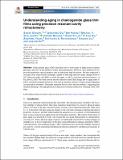Understanding aging in chalcogenide glass thin films using precision resonant cavity refractometry
Author(s)
Geiger, Sarah J.; Du, Qingyang; Huang, Bin; Shalaginov, Mikhail; Michon, Jerome; Lin, Hongtao; Gu, Tian; Yadav, Anupama; Richardson, Kathleen A.; Jia, Xinqiao; Hu, Juejun; ... Show more Show less
DownloadPublished version (2.511Mb)
Publisher Policy
Publisher Policy
Article is made available in accordance with the publisher's policy and may be subject to US copyright law. Please refer to the publisher's site for terms of use.
Terms of use
Metadata
Show full item recordAbstract
Chalcogenide glass (ChG) thin films have a wide range of applications in planar photonics that rely on the stability of their optical properties. However, most methods do not provide quantitative optical property data at sufficiently high resolution. We have employed a resonant cavity refractometry technique capable of detecting refractive index changes down to 10[superscript -6] refractive index unit (RIU) to study the aging, or sub-T[subscript g] structural relaxation kinetics, of Ge[subscript 23]Sb[subscript 7]S[subscript 70]ChG. Our study reveals that the refractive index (RI) change due to aging tends to follow stretched exponential behavior, with stretch exponents and rate of index change dependent on initial glass treatment. Thermally annealed devices show the best stability, suggesting that thermal annealing is the appropriate post-deposition treatment method for obtaining stable ChG films.
Date issued
2019-04Department
Massachusetts Institute of Technology. Department of Materials Science and Engineering; Massachusetts Institute of Technology. Materials Research LaboratoryJournal
Optical Materials Express
Publisher
Optical Society of America (OSA)
Citation
Geiger, Sarah et al. "Understanding aging in chalcogenide glass thin films using precision resonant cavity refractometry." Optical Materials Express 9, 5 (April 2019): 2252-2263 © 2019 Optical Society of America
Version: Final published version
ISSN
2159-3930